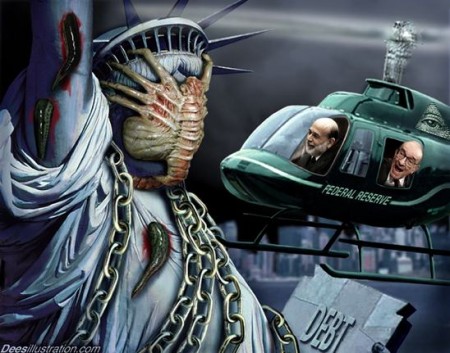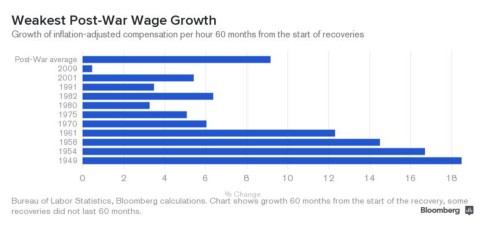– The Italian Job: How Borrowing And Printing Lead To An Economic Dead End (David Stockman’s Contra Corner, Aug 21, 2014):
Earlier this week Bloomberg published a devastating chart showing real hourly wage growth for the first 60 months of every cycle going back to 1949. The 11 cycle average gain was 9% and the largest was 19% a half century back.
Fast forward to the 60 months of ZIRP and QE since the Great Recession officially ended in June 2009, however, and you get a drastically different picture: Real hourly wages have risen by just 0.5%, and in the great scheme of things that’s a rounding error.
Surely the above chart is also flat-out proof that massive money printing doesn’t work. After all, reflating wages, jobs and incomes is what the monetary politburo claims it’s all about. Indeed, the Fed has insouciantly cast a blind eye to the massive bubbles building everywhere in the financial system, and has kept money market rates relentlessly at zero for six years running on the grounds that it is not yet done “stimulating” the labor market.
So why does this abysmally failed and dangerous experiment continue unabated—as Yellen will undoubtedly confirm at Jackson Hole? Self-evidently, it is irresistibly convenient to both Wall Street and Washington. The former gorges on a massive diet of carry trade gambling windfalls thanks to ZIRP and the Greenspan/Bernanke/Yellen “put”; and the latter gets a fiscal get-out-of-jail-free card owing to the Fed’s massive repression of interest rates. Indeed, with the public debt now topping $17.7 trillion, the implicit (and fraudulent) debt service relief from current ultra-low interest rates amounts to upwards of $500 billion per year.
Stated differently, where there should be extreme caution on Wall Street, there is actually irrational exuberance beyond Alan Greenspan’s wildest imagination back in December 1996. And where there should be fiscal panic in Washington owing to prospective red ink of another $15 trillion over the next decade (under “un-rosy scenario”), there is unmitigated and universal complacency.
The evil of monetary central planning, of course, is exactly what is unfolding: it drastically distorts pricing signals and thereby sows the seeds of eventual financial correction shocks and the consequent economic disorder. But there is something else, and its worse. Namely, the addiction to money printing and artificial debt fueled stimulus has become so deeply entrenched in the Wall Street-Washington corridor that the mainstream narrative has lost any semblance of historical perspective and realistic appreciation of the dead-end path on which the system is now embarked.
The monumental extent of monetary expansion and debt accretion since the turn of the 21st Century, for example, goes unrecognized, and is assumed to be merely a permanent and sustainable feature of the financial landscape. And that blindness might even be understandable had it been accompanied by an unusual surge of prosperity of the “party now, pay later” variety. In fact, however, the core metrics of prosperity——real GDP growth, breadwinner employment, investment in productive assets and real household incomes—-have all gone in the opposite direction, having fallen drastically below all historical norms.
The contrasts below are dispositive. Real GDP growth during the last 14 years has averaged only 1.8%—-barely half the average rate during the prior 50 years. Likewise, breadwinner jobs are still 5% below their turn of the century level; real net investment in plant and equipment is 20% below its late 1990s levels; and real median household income is down by 5%.
…

